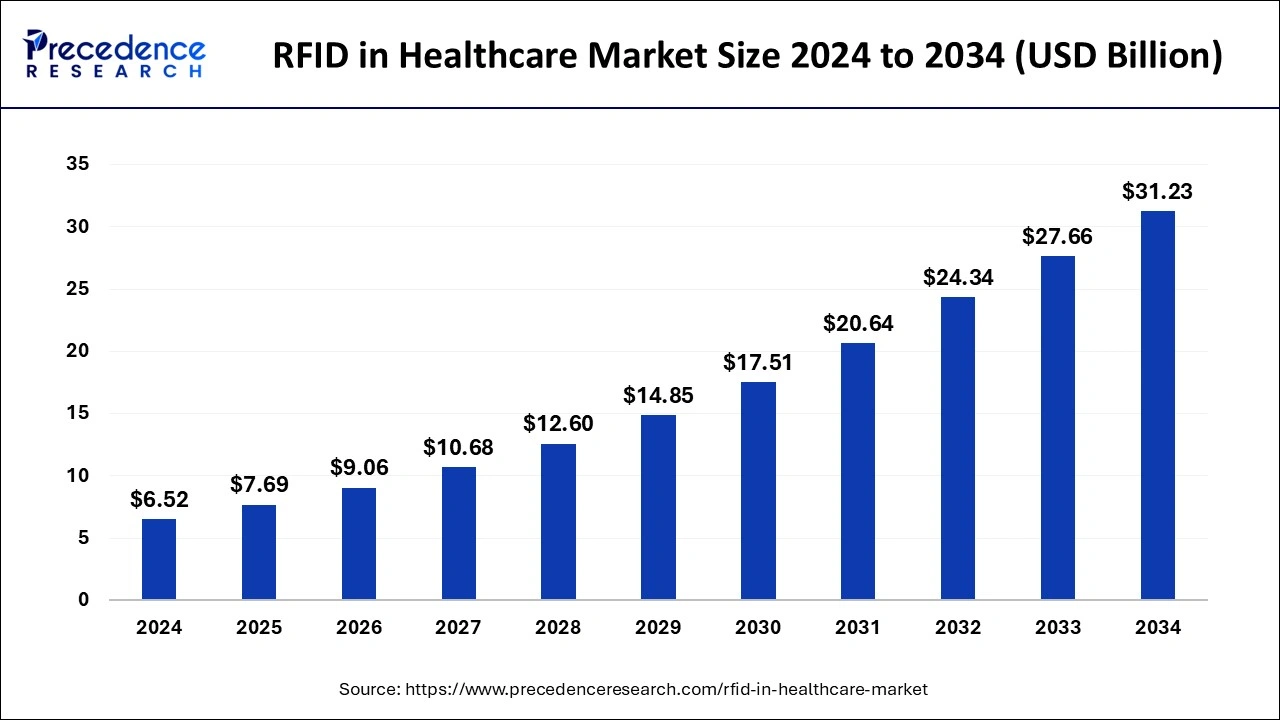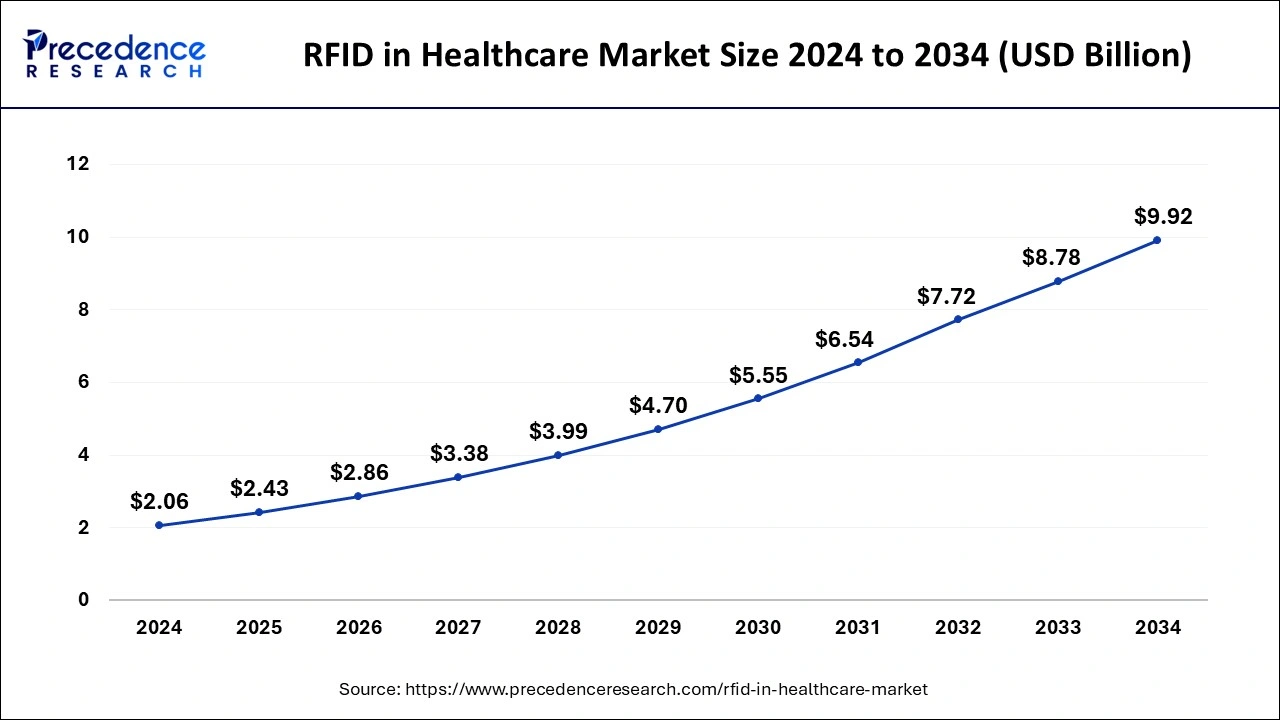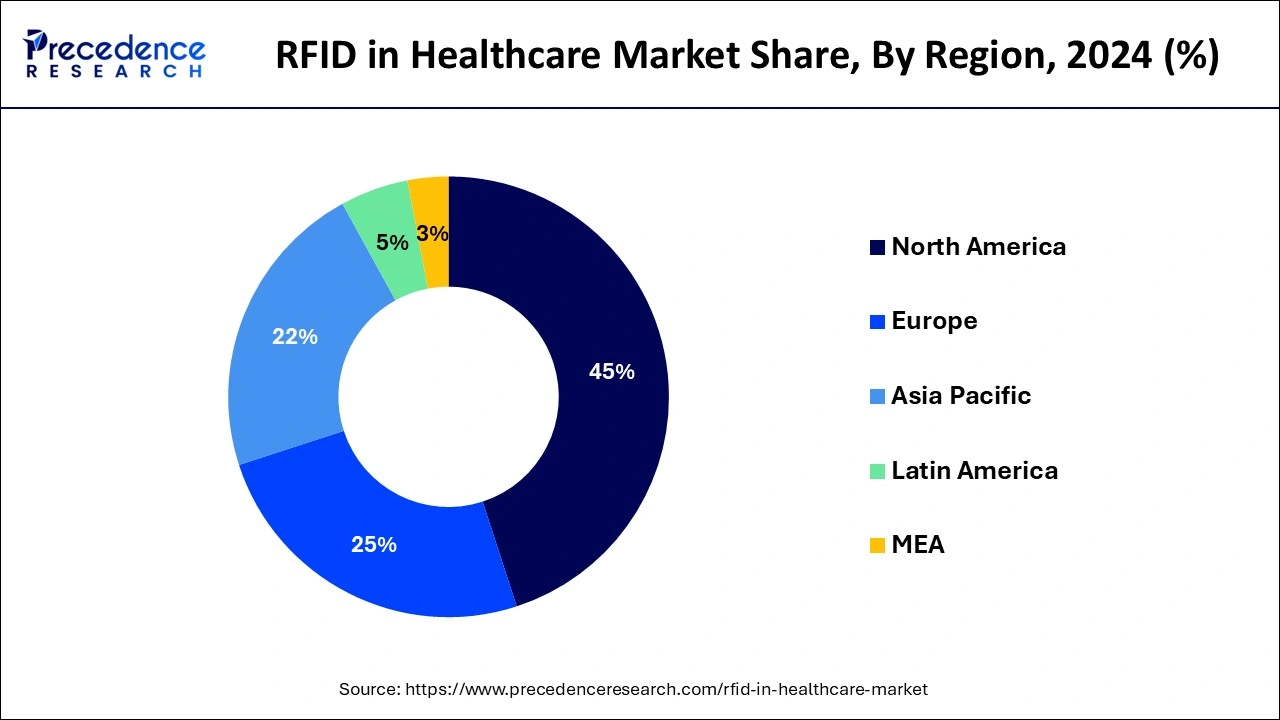January 2025
The global RFID in healthcare market size is estimated at USD 7.69 billion in 2025 and is anticipated to reach around USD 31.23 billion by 2034, expanding at a CAGR of 16.96% from 2025 to 2034. The North America RFID in healthcare market size reached USD 2.93 billion in 2024 and is expanding at a CAGR of 16.99% during the forecast period. The market sizing and forecasts are revenue-based (USD Million/Billion), with 2024 as the base year.
The global RFID in healthcare market size acounted for USD 6.52 billion in 2024 and is predicted to reach around USD 31.23 billion by 2034, growing at a CAGR of 16.96% from 2025 to 2034.

The U.S. RFID in healthcare market size was valued at USD 2.06 billion in 2024 and is expected to reach USD 9.92 billion by 2034, growing at a CAGR of 17.04% from 2025 to 2034.

North America dominated the global healthcare RFID marketplace due to the cumulative number of hospitals and the existence of regulations on patient safety. Europe can be assumed to be the second-most profitable market for healthcare RFID systems. The regional market benefits from promising government support in terms of funding and rigorous support of the development of the healthcare sector. Moreover, growing research and development in the region offers lucrative avenues for market expansion in the near future.
Asia Pacific is anticipated to be the fastest budding healthcare RFID market throughout the estimated period on account of refining healthcare infrastructure, increasing investments in the healthcare sector, and developments by market participants in the region. Also, nations such as China and India are seeing the fastest progressions owing to the growing government emphasis on implementation of novel technology, and the finest treatment selection from a developed country.

RFID technology in the healthcare sector is predicted to witness outstanding growth in the near future. Some of the prominent factors accelerating the growth of Improvement RFID in the Healthcare market include inventory management in pharmacies, hospitals, and biotechnology companies, and enhanced patient security by healthcare providers. Further, the high efficiency and low cost of RFID systems and the implementation of automated processes in pharmacies and hospitals are spurring market demand. Also, intensifying research and development operations by non-profit organizations and rigorous strategies adopted by top participants like expansion, mergers, and partnership for the development of new-fangled technologies to reinforce RFID in healthcare also improve the growth of the market. For illustration, Harland Simon, a chief provider of location tracking solutions partnered with PervasID for presenting novel RFID reader technology to the market. It is a Cambridge-based and award-winning technology firm.
The Growing requirement to avert expiry, spoilage, and counterfeit products from coming into the market and the cumulative requirement to help adhere to the FDA's Drug Supply Chain Security Act, MHRA, and other regulatory establishments. The growth of this market is powered by the snowballing installation of RFID in manufacturing units for efficiency enhancement; augmented practice of access and security control applications and swelling government initiatives. Huge implementation of RFID technology in the retail sector, and development in the RFID ecosystem via organic growth strategies like acquisitions and mergers, and collaborations further aid in market progression.
However, a few limiting aspects for the development of the healthcare RFID market are more installation cost of RFID systems in healthcare and systems interoperability. RFID adoption in any industry needs huge investments for readers, tags, software, electricity, and running replacement services. Further additional features like IoT integration, accuracy checking of the system, and training charges increase expenses for RFID solutions.
| Report Highlights | Details |
| Market Size in 2024 | USD 6.52 Billion |
| Market Size in 2025 | USD 7.69 Billion |
| Market Size by 2034 | USD 31.23 Billion |
| Growth Rate From 2025 to 2034 | CAGR of 16.96% |
| Largest Market | North America |
| Base Year | 2024 |
| Forecast Period | 2025 to 2034 |
| Segments Covered | Product, Application |
| Regional Scope | North America, APAC, Europe, Latin America, MEAN, Rest of the World |
Different products in the healthcare RFID product market comprise monitors, RFID tags, printers, software, and readers among others. RFID tags can be employed for pharmaceutical and asset tracking, and patient and blood monitoring systems tracking. Whereas the hardware and software are employed for displaying and reading the information on the RFID tags. Among product segmentation, RFID systems are projected to grasp the principal market stake over the prediction period. These systems are normally employed for equipment, personnel, and inventory tracking in healthcare settings and in hospitals. Additionally, these systems are employed for patient monitoring and to avert the distribution of forged devices and drugs.
Owed to features such as low cost, small size, and extended lifetime, passive tags are anticipated to gain more grip compared to active tags. Passive UHF RFID tags have also observed a large acceptance after the development of the RAIN RFID alliance. With members like AIDC industry association AIM Global, Impinj, Google, Intel and SMARTRAC, the alliance has efficiently worked on a spread of alertness among the users and probable customers.
Different applications assessed in RFID in healthcare market reports are tracking and monitoring. Pharmaceutical tracking application generates prominent revenue due to the growing acceptance of the technology to recognize counterfeit drugs. Pharmaceutical tracking systems are measured as helpful to patients, organizations, and supply chain partners. In recent times, there has been an upsurge in the propagation and distribution of forged drugs that stance an augmented risk for health hazards.
The RFID technology supports in detection and screening of such drugs and aid in ceasing the spreading in the market. Besides, this technology helps pharmaceutical companies with efficient inventory managing tasks and minimalizing labeling blunders. These compensations help lessen the waste and thus cut the undesirable costs incurred.
Major companies are concentrating on the strategies such as new-fangled product promotions and expansions, advances, contracts, and partnerships to augment their product offerings and inflate their business. Likewise, they have introduced advanced technologies in tags and gateways which are presently encouraging the growth of the RFID market.
This research report includes a complete assessment of the market with the help of extensive qualitative and quantitative insights, and projections regarding the market. This report offers a breakdown of the market into prospective and niche sectors. Further, this research study calculates market revenue and its growth trend at global, regional, and country from 2025 to 2034. This report includes market segmentation and its revenue estimation by classifying it on the basis of product, application, and region as follows:
By Product
By Application
By Regional Outlook
For inquiries regarding discounts, bulk purchases, or customization requests, please contact us at sales@precedenceresearch.com
No cookie-cutter, only authentic analysis – take the 1st step to become a Precedence Research client
January 2025
October 2024
September 2024
April 2025